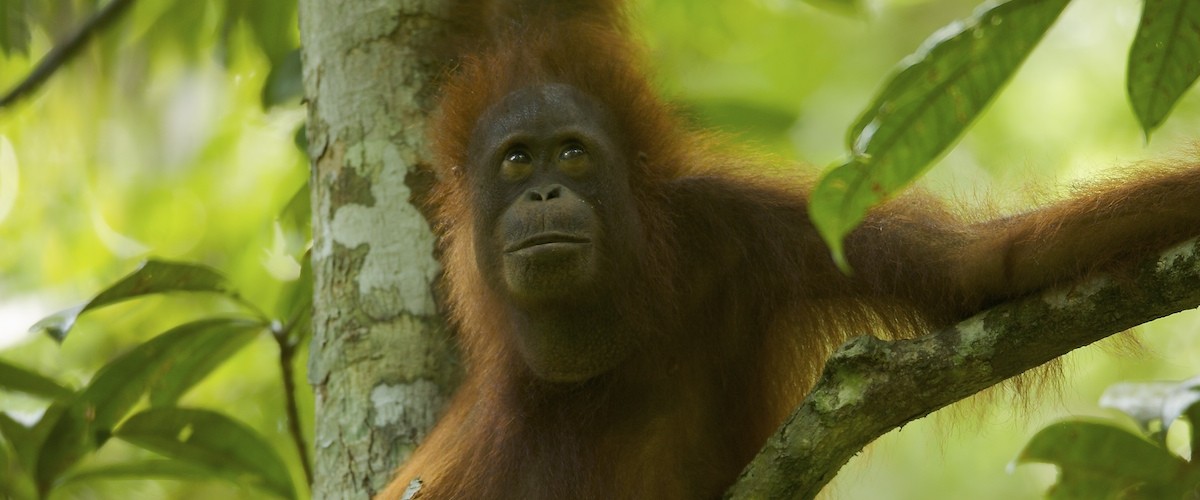By Taylor Tench, Senior Wildlife Policy Analyst, Environmental Investigation Agency (EIA)
It is no secret that orangutans are facing a dire conservation outlook. All three orangutan species – the Bornean orangutan, Sumatran orangutan, and Tapanuli orangutan – are Critically Endangered with habitat loss and illegal killing among the main drivers of orangutan population declines.
In October 2021 my organization, the Environmental Investigation Agency (US), launched a new campaign to protect wild orangutans. To kick off the campaign, we published a report entitled Orangutans in Crisis that explored how direct drivers of orangutan loss, certain government policies, and law enforcement challenges are closely interconnected and continue to drive orangutan population declines in Indonesia.

Every year, orangutan habitat shrinks and becomes more fragmented because of forest conversion for agriculture, infrastructure, mining, and other human activity. According to a spatial analysis conducted by EIA together with MapHubs of government deforestation data on orangutan habitat, an estimated 797,054 hectares of orangutan habitat was deforested in Indonesia and Malaysia from 2016 through 2019. The vast majority – 739,249 hectares – occurred in Indonesia.
Illegal killing is the other major threat to orangutan survival and is often, though not always, closely linked to habitat destruction. Human-orangutan conflict, poaching for meat, and fear of wild orangutans are among the motivations for orangutan killing, which on average claim the lives of an estimated 2,200 Bornean orangutans each year. Orangutans typically give birth only once every seven to eight years, and studies have shown that the loss of just one percent of adult female orangutans from a given population can cause that population to decline.
When it comes to laws designed to protect orangutans and other threatened species from harm, Indonesia’s Conservation Law of 1990 is strong. The Conservation Law prohibits anyone from catching, injuring, possessing, transporting, and trading an orangutan. Violations are punishable by a maximum prison sentence of five years and a fine of IDR 100 million (USD $6,400). However, orangutan crimes are rarely prosecuted, and when they are, penalties are typically light. EIA is not aware of any instance in which someone received the maximum allowable penalty for killing or trafficking an orangutan.

To address these and other issues facing orangutans, EIA included a suite of policy recommendations in our report that encourage Indonesia to take a comprehensive and multifaceted approach to protecting all remaining orangutans and their natural forest habitats, including the adoption of a revised Orangutan Conservation Strategy and Action Plan and expediting recognition of customary forests that comprise orangutan habitat. You can learn more about EIA’s recommendations here.
Thankfully, there is reason to be hopeful. Deforestation in Indonesia declined dramatically in 2017 and continued to fall through 2021. There are also a number of excellent conservation organizations working on the ground in Indonesia, together with the Indonesian government and local communities, to protect orangutans and their habitat, like the Gunung Palung Orangutan Conservation Program/Yayasan Palung. EIA is proud to support GPOCP/Yayasan Palung’s successful programs in West Kalimantan that raise conservation awareness, support sustainable livelihoods, address orangutan crime, conduct scientific research, and restore orangutan habitat through the establishment of community forests.
There is still much more to be done, but thanks to the efforts of GPOCP/Yayasan Palung and countless others working around the clock to protect orangutans, Asia’s only great apes stand a fighting chance to not only survive, but once again thrive, in the rainforests of Borneo and Sumatra.







